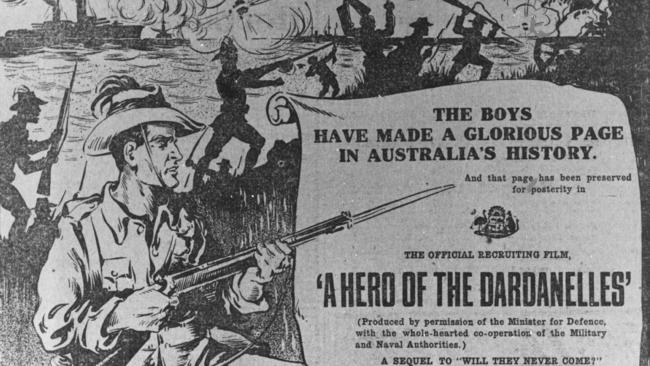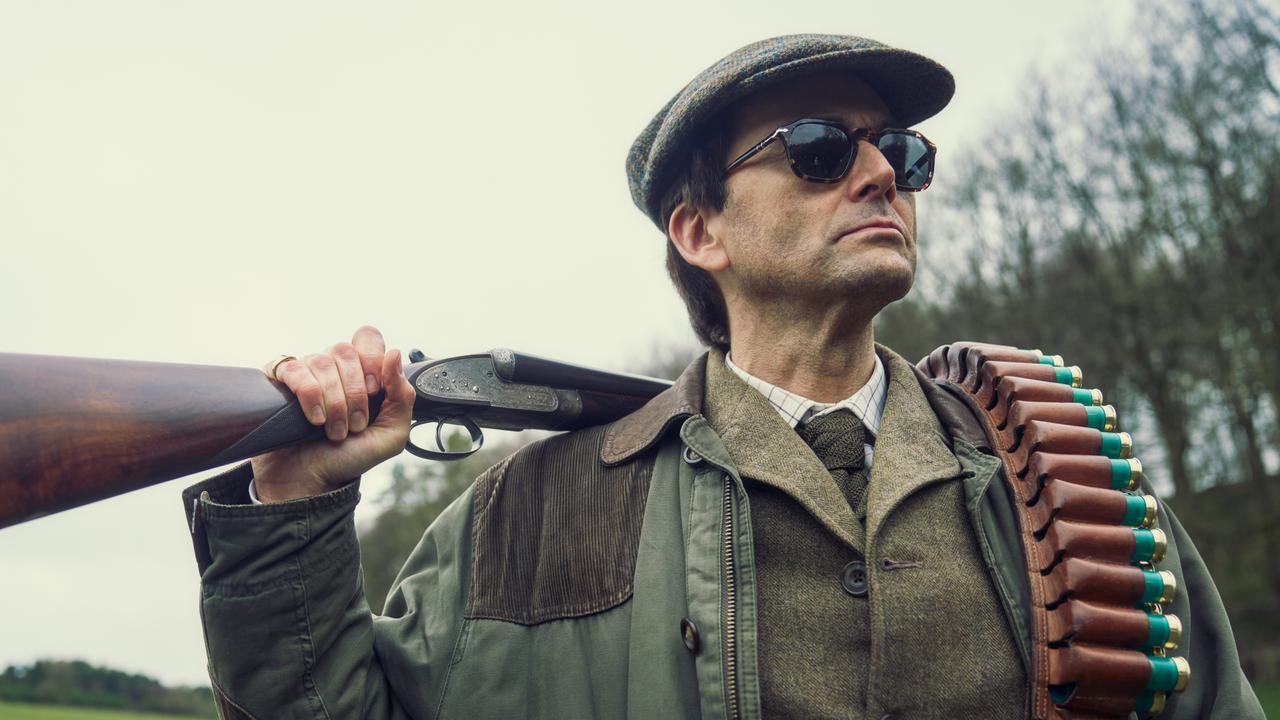War Pictures film exhibition brings World War I into focus
AN exhibition in Melbourne’s ACMI marks the centenary of World War I and looks at how we viewed it on film.

AUSTRALIA was quick to adapt to cinema. We made what is regarded as the first surviving full-length feature film, The Story of the Kelly Gang, in 1906. By 1911, there were more than 100 permanent and temporary cinemas in Sydney, and in 1912 the first colour films were screened in Australia.
Then we went to war. It didn’t necessarily quell our appreciation for the new screen form. Indeed, for most Australians the cinema screen was the only tangible way to experience World War I — or be distracted from it.
A new exhibition at the Australian Centre for the Moving Image, in conjunction with the National Film and Sound Archive of Australia, commemorates the centenary of World War I and looks to replicate the way Australians viewed it on screen.
The centrepiece of War Pictures: Australians at the Cinema 1914-1918 is the modern re-creation of an early 20th-century “picture palace” showing extracts from the films Australians saw when they went to the cinema during the era.
Curator Fiona Trigg says free hour-long screenings at Melbourne’s ACMI will give viewers a “a sense of the variety and the breadth of material that was available 100 years ago”. More than 30 pieces assembled from the NFSA archive and the Australian War Memorial give a sense of the spectacle, entertainment and information cinema provided during the war.
The material is deliberately varied, partly because research shows audience tastes varied through the war era, as did the kind of cinema being made. During the early days of the war, most cinema items were short and focused on the facts, such as industrial films showing manufacturing processes and our boys heading off to war. Some were patriotic without being jingoistic, until feature films became part of the landscape around 1915-16.
Two featured in the ACMI screening are the DW Griffith epic Birth of a Nation and the escapist Italian-made Roman epic Cabiria. Another pure entertainment included is Neptune’s Daughter, starring our own Annette Kellerman, a film star and professional swimmer. Charlie Chaplin also features. He was Hollywood’s biggest star at the time after making his first film in 1914; he’d made 50 movies by the end of the war.
Trigg says it is “just a tragedy” so many Australian films made during the period didn’t survive. Between 1914 and 1918 we made about 54 feature films, yet only about 12 still exist.
One of the most striking to survive is The Hero of the Dardanelles, the first feature film made about the Gallipoli landing, produced just months after the event and re-creating the landing on Sydney’s Tamarama Beach.
Trigg says it was a turning point for audiences. “At the beginning of the war there was a rush to make patriotic films but as the war went on and so many people lost family members and the impact was so traumatic, people didn’t want to see that patriotism because it didn’t ring true,” she says.
A Hero of the Dardanelles dramatised the event with actual documentary footage, including images of the soldiers relaxing in Egypt at the pyramids, a later inspiration in Peter Weir’s Gallipoli. But even that film was lost for years before re-emerging in a composite film in 1928. Its Gallipoli landing re-creation is often shown as the “real” landing.
It and a British documentary made in 1916, The Battle of the Somme, went some way to affecting cinema audiences. The Battle of the Somme was a global sensation, playing to 20 million people in Britain, and stunning viewers as the most realistic representation of what was happening on mainland Europe.
“It had more detail than most of the other films, which were controlled by government and showed the positive side of war, so to speak,” says Trigg. “This showed life more in the actual battlefields and it’s quite full-on, with men carrying injured men, and you look at the men’s faces and they show such trauma.”
The trauma pushed audiences away from the war towards comedy. Bush comedies, which became a constant in Australian cinema for decades, rolled into production, including offerings such as Hayseeds and The Waybacks. They led to the first Dad and Dave film being made by Raymond Longford in 1920, On Our Selection.
“I think it was just too difficult to make a war film that didn’t distress people,” Trigg says, adding a few melodramas about dastardly German spies were made without really changing the landscape.
Despite the flux, Australians continued to go to the cinema, which was dominated by Hollywood and local product because of the obvious ravages on Europe. By 1919 it was clearly our most popular entertainment, with admissions reaching 67.5 million at 750 picture theatres across the country.
Trigg is thrilled to show “this part of Australian film history which doesn’t get looked at very often”, although she appreciates the difficulties modern audiences may have with the antiquated footage.
“It’s hard to contextualise silent footage from 100 years ago, and it can be difficult for contemporary audiences to read but it’s fascinating,” she says. “It just needs a little help.”
That help includes fashioning the screening room into an old-fashioned cinema with a foyer and video of a ticket seller in a booth. The hour-long footage will include everything from ads — “some cute advertisements for starch and garden hoses” — and newsreels to excerpts from comedy and dramatic features, accompanied by specially commissioned scores from solo piano through to music for a full orchestra.
Trigg says War Pictures is not only the biggest collaboration ACMI has done with the NFSA, it is also the biggest collection of Australian footage ACMI has had in one exhibition. That is perhaps a telling point, given the steady run of Hollywood-dominated blockbuster exhibitions rolling through the Melbourne screen museum. The real sadness is that it took a war to make it happen.
War Pictures: Australians at the Cinema 1914-1918 is a collaboration between the Australian Centre for the Moving Image and the National Film and Sound Archive of Australia. The free exhibition will show at ACMI until July 12.


